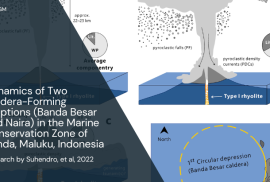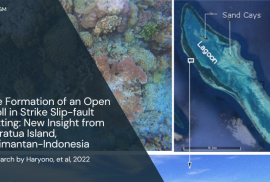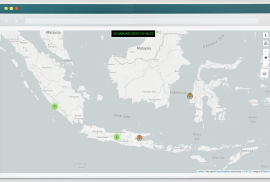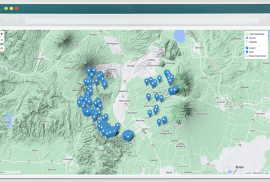R Studio merupakan metode analisis data interaktif yang sedang berkembang saat ini. R terintegrasi untuk manipulasi data, kalkulasi, dan tampilan grafis dengan berbagai macam package. R dapat diterapkan dalam studi geografi seperti pada geomorfologi. Package-package pada R dapat digunakan pada data geomorfologi, sebagai contoh untuk menampilkan plot data LiDAR hingga melakukan visualisasi data dengan package ggplot2, serta package-package lainnya. Package ggplot2 mampu menghasilkan statistik, data, ataupun grafik.
Data geospatial memerlukan perangkat lunak untuk pengolahannya. Terdapat berbagai macam perangkat lunak dalam pengolahan data geospatial baik yang berbayar maupun opensource. Perangkat lunak opensource yang dapat mendukung pengolahan data geospatial antara lain QGIS, ILWIS, dan SAGA.
Pelatihan ini bertujuan untuk mengenalkan perangkat lunak opensource yang digunakan untuk analisa data geomorfologi longsor. Silabus dalam pelatihan ini sebagai berikut,
Silabus:
- Perangkat lunak meliputi QGIS, ILWIS, SAGA
- Input data vektor
- Input data raster
- Basic raster modeling
Tarif: Rp 2.950.000,00
Fasilitas:
- Training kit
- Sertifikat
- Coffee breaks
- Makan siang
- Forum diskusi alumni
Durasi Pelatihan: 3 hari
Research by Anshori et al., 2022
Participatory landslide inventory mapping using the Volunteered Geographic Information (VGI) mobile app is a promising method to produce a landslide inventory map. The aim of this research is to describe the development and implementation of the VGI mobile app for participatory landslide inventory mapping. The architecture VGI mobile app is developed on the basis of Free Open-source Software for Geospatial Application server-client software to ensure reproducibility and flexibility, and to reduce cost. Anyone can reproduce, modify, and share the code, which suggests improvement in the collective ability to use, prepare, and landslide inventory update. Landslide inventory using VGI mobile app shows that the tool and method successfully map landslides in the landslide prone area (Magelang Regency, Central Java Province, Indonesia) with fairly high levels of effectiveness and convenience. Magelang Regency, one of the landslide prone areas in Java, is located in the intermountain basin surrounded by Menoreh Mountain, Merapi, Merbabu, Suropati-Telomoyo Complex, and Sumbing Volcano.
Research by Suhendro et al., 2022
This is the first study discussing the dynamics of two caldera-forming eruptions in the Banda volcanic complex (BVC) in the marine conservation zone of Banda, Maluku, Indonesia. The first and second caldera episodes are, hereafter, termed as Banda Besar and Naira, respectively. The formation of Banda Besar caldera (ca. 8×7 km) ejected homogeneous rhyolitic magmas (bulk-rock, 73.1–73.8 wt.% SiO2) in the following three stages: (1) sub-Plinian (BB-5a), (2) intra-sub-Plinian flow (BB-5b), and (3) caldera collapse (BB-5c and BB-5d). The BB-5a stage produced a reversely graded white pumice fall layer with moderate lithics (2–11%), which originated from a sub-Plinian eruption with an estimated plume height of 22–23 km. Subsequently, intensive erosion of wall rock (13–25%) causes conduit enlargement, leading to the partial collapse of the eruption columns, forming intrasub-Plinian flow deposits (BB-5b). It is likely that conduit size surpassed the minimum threshold value for a buoyant plume during the final phase of the second stage, causing the complete formation of a pumice-rich pyroclastic density current (PDC) during the early-third stage (BB-5c). Finally, the evacuation of voluminous magma from the reservoir yields the first caldera collapse during the late-third stage, producing a lithic-dominated PDC with minor pumices (BB-5d).
Research by Haryono et al., 2022
This study aims at reconstructing the mechanism explaining the formation of the V-shaped open atoll of Maratua Island. The reconstruction was conducted by examining the landforms, lithology, and geological structure of the region. We first examined the island through ALOS, SRTM image and using an oblique aerial photograph taken using a drone. Then, a field survey was conducted to identify the detailed morphological features, lithology, and structure of the area. The results reveal that the island has developed into seven different landforms, namely, karst ridge, undulated karst hills, structural valley, marine terrace, beach, fringing reef, and sand cays. The sinistral fault system is the major factor that controlled the Maratua Island’s formation, wherein the island is a push-up morphology of the fault that formed a carbonate high. Accordingly, the atoll formation seems to be an inheritance of eroded rollover anticline of Pliocene carbonate or older and continuing to the present time. The open atoll is caused by the southern block’s downward movement resulting from an oblique subsidiary sinistral fault mechanism. The research findings unveil new mechanism of atoll formation in the strike-slip fault setting that enrich the previous models.
Laboratorium GLMB bekerjasama dengan Kementrian Lingkungan Hidup dan Kehutanan membuat platform untuk monitoring DAS (Daerah Aliran Sungai) setiap wilayah kerja. Platform berbasis website tersebut bernama SIPDAS.
Intip lebih lanjut pada link berikut;
http://sipdas.menlhk.go.id/
PEPARING; Pemetaan Partisipatif Inventarisasi Longsor
Merupakan platform untuk melakukan pemetaan inventarisasi longsor secara partisipatif. Hasil inventarisasi ditampilkan melalui website berikut:
Lorem Ipsum is simply dummy text of the printing and typesetting industry. Lorem Ipsum has been the industry’s standard dummy text ever since the 1500s, when an unknown printer took a galley of type and scrambled it to make a type specimen book. It has survived not only five centuries, but also the leap into electronic typesetting, remaining essentially unchanged. It was popularised in the 1960s with the release of Letraset sheets containing Lorem Ipsum passages, and more recently with desktop publishing software like Aldus PageMaker including versions of Lorem Ipsum.










